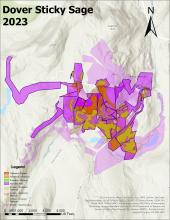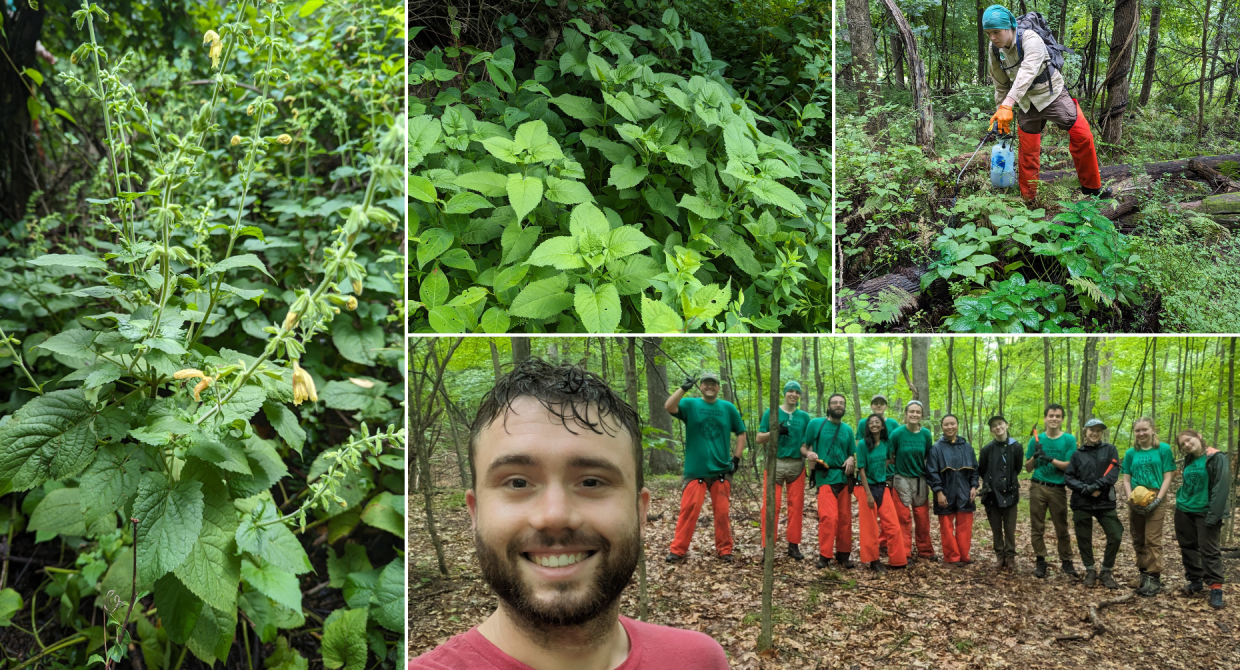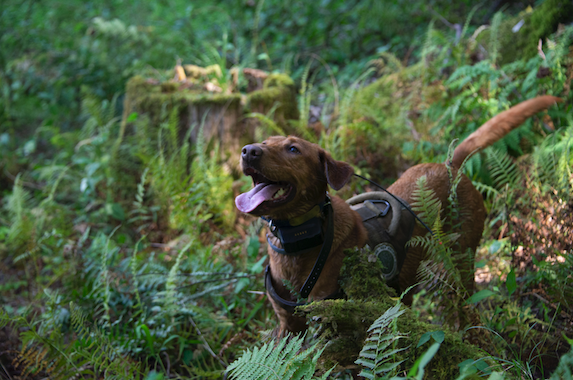
Sizing up Sticky Sage
Title

Body
Sticky sage (Salvia glutinosa, glutinous sage, Jupiter’s sage, Jupiter’s distaff), an emerging invasive species in the Lower Hudson Valley, is a nemesis of Ryan L. McClean, the Terrestrial Invasive Species Project Manager for the New York-New Jersey Trail Conference (Trail Conference) under the Lower Hudson Partnership for Regional Invasive Species Management (LH PRISM). Sticky sage is an herbaceous perennial plant in the mint family native to Europe. Like many invasives in our region, sticky sage is sold as an ornamental garden plant and has recently been observed exhibiting invasive characteristics in multiple New York locations (see here for species ID). This species tolerates a wide range of sun exposure and soil moisture conditions and can reproduce via sticky seeds hitchhiking on animals and hikers, and also underground via clonal root reproduction. Because of the robust nature of sticky sage, the ease of spread, and avoidance of deer herbivory and other predation, sticky sage has the capacity to form monocultures on forest floors. These monocultures push out native plants, causing a cascading reduction of biodiversity and ecosystem health. Since everything humans need and love comes from nature, this has huge implications for human health as well.
There are only three known infestations of sticky sage in New York State. Because of the low number of infestations and the devastating potential impacts of this species, it is classified as a Tier 2 emerging invasive species with the goal of regional (and statewide) eradication. One infestation is in the Finger Lakes region, which Ryan McClean alerted their peers in the FL PRISM of the infestation. This year, it was surveyed (and found to be quite extensive across 17 acres) and management efforts began. A second infestation is located in Westchester County on a small private property. The site was first visited in 2017 when 210 plants were removed. Pulling yearly, less and less sticky sage was found until finally, no sticky sage was found at this site in 2022. The site was monitored again in 2023 and there was no sticky sage present! As a new invasive species, there is not much information available about sticky sage’s ecology, including seed bank longevity. Not finding sticky sage at this infestation two years in a row after five years of management has huge implications for sticky sage management; the seeds in the soil may no longer germinate after five years!
(Map of management area in Dover - click to enlarge)
The third infestation, located in Dutchess County, was discovered in 2009 and management began by the National Parks Service in 2013. In 2016 the Invasives Strike Force (ISF) joined to help with management, and they ramped up their efforts significantly in 2019. Over the years, community members were contacted, and permissions were obtained to manage sticky sage on parcels adjacent to known infested parcels. Now, nearly 20 landowners and land managers are involved with sticky sage removal. What’s especially nefarious about this 70+ acre infestation is that the Appalachian Trail cuts through it. The sticky seeds can hitch a ride along the trail, which runs from Georgia to Maine. If a seed ends up in a favorable spot (which is likely, as sticky sage tolerates a wide range of conditions), a new infestation can form far away from the parent population. Managing this infestation is of national importance as natural areas along the entire east coast are potentially at risk.
(Take a deeper dive into this story with this video)
Each year, the ISF prioritizes managing sticky sage along the Appalachian Trail first to mitigate the risk of spread. Then begins the monumental task of surveying hundreds of acres (in 2022, over 300 acres, or about half the area of Central Park in New York City, were surveyed!) to eliminate sticky sage. Historically, management has primarily been done via a foliar spray of herbicide. This management method was selected because it was much more efficient and effective than manual removals in dense monocultures and in difficult terrain. However, after multiple years of treatment, many of these sites have diminished significantly, from dense monocultures to scattered plants, and manual removals can now be prioritized in some areas. Management has been incredibly effective. Prior to 2021, infestations were too dense to count the number of plants managed. In 2021, over 46,000 plants were managed across 63 acres. In 2022, just under 26,000 plants were managed over 72 acres. In 2023, just under 15,800 plants were managed over 65 acres. Although there is still quite a bit of sticky sage, seeing a 66% decrease in the infestation over two years of management is incredibly encouraging.
The Trail Conference’s Conservation Dogs program has also joined the sticky sage eradication efforts. Conservation dogs have been trained to sniff out sticky sage and are particularly helpful in establishing the boundaries of the infestation, checking for missed plants in areas previously managed by the ISF crew, and surveying areas where sticky sage is far and few between. Knowing the boundaries of an infestation is critical for management planning, and by ensuring that every sticky sage is managed in an area, we can achieve eradication sooner.
There are a few hurdles to eradicating sticky sage. The first is lack of information. Although we can make an anecdotal observation that the seed bank may be viable for five years, this information is not conclusive. If there are other unknown infestations of sticky sage in New York, they will continue to grow and spread until they are noticed. Sticky sage can still be sold and purchased in New York, so the possibility of it escaping from a garden into a natural area remains high. Most community members have gotten on board with sticky sage removal, however, there are still a few outstanding permissions to obtain. Capacity is also severely limited. The ISF, a small crew with a regional jurisdiction and many other high-priority target species, spends around four weeks of their six-month field season managing sticky sage and has never completely managed the infestation in Dutchess County. Missing a single seed-bearing sticky sage sets the end of the project back as long as the seed bank vitality (in this case, likely five years).
With these obstacles to overcome, Ryan McClean remains optimistic and persistent. The number of land managers involved steadily grows from year to year, allowing the ISF to survey and manage new areas. There are now large areas that have been searched with sticky sage not found surrounding the infestation. With the addition of a handful of permissions obtained, if sticky sage is not found, the boundaries will be fully known. Areas that have been managed show a drastic reduction of sticky sage. If similar resources can be allocated towards this project, and the few outstanding permissions can be obtained, eradication of sticky sage is possible!
NOTE: Please do not purchase, plant, or give away sticky sage. If sticky sage is observed in natural areas, it should be reported to iMapInvasives or iNaturalist.

